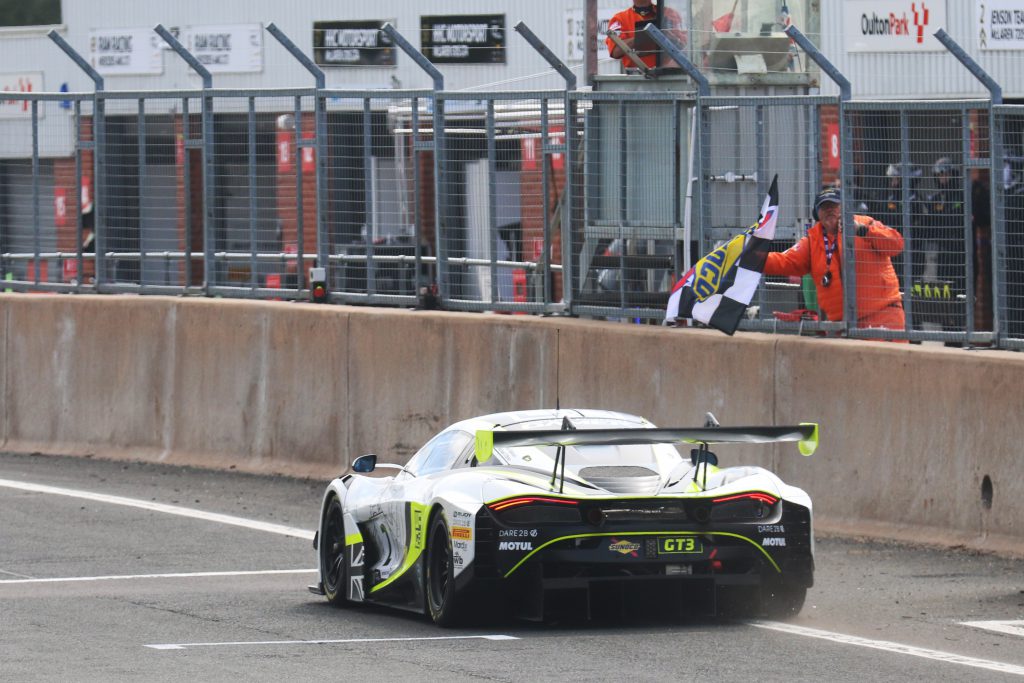With his debut season in British GT almost at an end, James Baldwin has unquestionably demonstrated that his exceptional skill on simulators and in esports is transferable to the real world.
His World’s Fastest Gamer win last year landed him a year in British GT with Jenson Team Rocket RJN and he and his team-mate Michael O’Brien won at Oulton Park in the first race of the season.
Despite how quickly Baldwin got used to his McLaren 720S GT3, the transition from sims to the real deal hasn’t been as simple as he’s made it look.
The consequences of making a mistake and skidding off track, even if the car sustains no damage, and the limited track time have been big learning experiences for him.
Having practiced extensively for each event using Assetto Corsa Competizione, he’s found there the way the car feels in dry conditions to be very similar to how it is in real life.
However if it happens to rain during the race weekend, then his experiences on the sim aren’t as helpful.
“In the simulator the wet physics are probably a big weakness of where sims are at today, I’ve noticed that a lot this year,” Baldwin tells The Race.
“In the dry it’s very comparable, in the wet there’s too much grip on simulators, there’s no wet lines versus dry lines – it’s just different and it’s not quite there yet.
“So in the real world I’ve had to learn that on the job completely, no practice has really helped that.”
As a sim racer there is far less teamwork off track given the more casual nature of sim racing and the need for large crews of people in real world motorsport.
Baldwin admits he’s had to adapt to the more professional nature of real world motorsport and best utilise the team he has around him.
This has been most prevalent when he’s given feedback on the setup of the car at each race weekend.
“In the sim world when you come in from a session or you stop or you’ve done a race or whatever, the majority of what you learn going forwards you’ll just think about and store it in your head,” Baldwin said.
“But in the real world you have to feedback how the car’s feeling to two or three engineers, the mechanics; if there’s any issues with the car, could it be quicker?
“Translating what you’re thinking into talking has been a bit of a challenge because I obviously think a certain thing in my head but to try and get other people to understand that – it’s harder than it sounds.”
The minutiae of being a racing driver has also been something Baldwin’s had to learn and adapt to since his British GT debut in August.
Usually sim racers only practice hot laps or race stints, but being in a real world race demands a far greater breadth of events which need to be rehearsed and practiced at length.
“In esports you’re just turning up, getting on your simulator, logging in and getting on with it,” he adds.
“So there’s a lot more to [real world racing] and you’ve got to do all of it and you’ve got to do it on time and you’ve got to do it well and there’s a lot of effort put into those things behind the scenes.
“To start with again I was probably thinking ‘oh this is pointless why am I spending two hours focusing on pit stops?’, but it’s all a part of the race time and it all matters.”
James Baldwin goes into this weekend’s British GT Championship finale with a title chance and with 2009 Formula 1 world champion Jenson Button as an extra team-mate.
You can watch the Silverstone 500 live on The Race YouTube channel and check back on Friday when we’ll have an in-depth interview with Baldwin about the highs and lows of his British GT season and what it means to race against one of his childhood Formula 1 idols.






